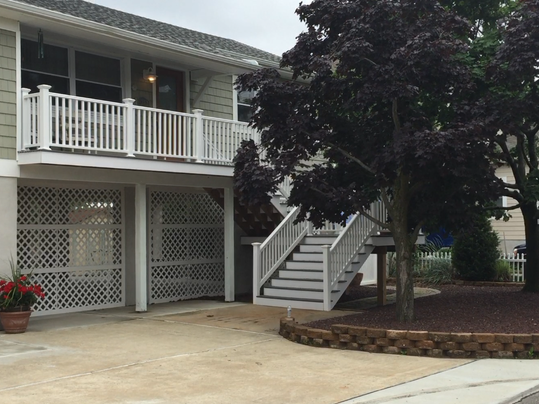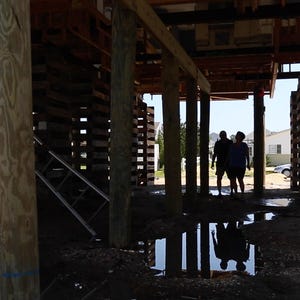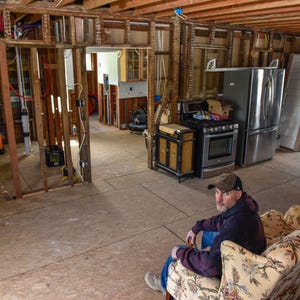TOMS RIVER – Leo Brancato learned the hard way that when you’re part of the RREM program, your home is not your own.
New Jersey says only 64 out of roughly 8,600 homes have been released from the Rehabilitation, Reconstruction, Elevation and Mitigation program, the state’s largest reconstruction program for homeowners trying to rebuild after superstorm Sandy.
Hundreds of those homes have been rebuilt and elevated, but a deed restriction, which is placed on all homes, remains for nearly all. While that deed restriction is in place, homeowners can’t sell their homes — even if they think they’re done with the program.
Most homeowners, like Brancato, don’t know that when they sign up for RREM, they’re allowing the state to severely curtail what they can do with the property.
Brancato spent months attempting to have the deed restriction released so he could sell his waterfront house. Although he had a certificate of occupancy and an elevation certificate that confirmed the house has been lifted to more than 13 feet above sea level, he was unable to persuade the state to lift the restriction until earlier this month — one year after reconstruction on his home was finished..
“I’ve jumped through all the hoops,” said Brancato, 63, in June. “I can’t get out of the RREM program.”
Every recipient of a RREM grant — 8,642 homeowners in New Jersey have been approved — signs something called the Declaration of Restrictive Covenant. As of July 17, only 64 homes had been released from the covenant and are truly out of the program, even though the state reports that 1,349 homes have been rebuilt — although not necessarily elevated yet — through RREM.
The covenant is meant to give the state leverage to demand that the work being paid for with federal money meets minimum federal, state and local home construction and environmental standards. The only ways to remove the restriction are to comply with the program’s requirements or pay back the grant.
That means that homeowners such as Brancato, who choose to act as their own general contractor through the program’s Pathway B, would be responsible for ensuring — and proving — that these standards have been satisfied and for setting up the final inspections. That’s where some avoidable delays originate, said Tammori Petty, a spokeswoman for the DCA.
“In some instances homeowners don’t immediately self-report their completion, which is critical to initiating closeout,” Petty told the Asbury Park Press.
Through RREM Pathway C, in which the state assigns a general contractor to oversee the reconstruction, that contractor would be responsible for ensuring these standards have been satisfied and for setting up the final inspections. A homeowner in Pathway C who isn’t planning on listing his or her home in the next year or two might not ever realize that such a limitation on ownership ever existed.
Brancato, a retired teacher who taught science at Pemberton Township High School, was in Pathway B and managed the rebuilding and elevation of the home after receiving $119,000 from RREM and additional money from flood insurance. His Windsor Avenue home, which was his permanent residence, is perched on a white sand beach along Goose Creek, with direct access to Barnegat Bay.
He decided to sell the property even before Sandy struck. Then Sandy’s surge flooded the entire neighborhood, bringing 13 inches of water into the home and coating the floor with inches of thick muck. Not only did he lose all his appliances, he lost dozens of personal items, including guitars, amps and records.
Brancato received a certificate of occupancy from the township on May 30, 2014, but later had to have his house tested for lead paint. That happened in December 2014.
His RREM project manager, from CB&I Shaw, was the one who delivered the bad news that the house was not his to sell.
“She said, ‘By the way, you know you can’t sell your house,’ ” Brancato said. “I thought: ‘Finally I’ve got the money. I thought I had all this crap behind me. And now this?’ ”
His real estate agent, Jeanne Keyasko of Diane Turton Realtors in Toms River, was equally perplexed.
“I have an offer right now on this house,” Keyasko said of the four-bedroom, two-bathroom home, which is listed for $529,000. “We’re getting so many showings on this house. It’s busy. I’ve been with Diane Turton for 30 years now, and this is a first.”
Still paying taxes
Brancato, who has been living in a retirement community in Manchester since a few weeks after Sandy struck, said he has continued to pay $1,800 a quarter in property taxes on his home, in addition to paying for rent in Manchester.
Two weeks after the Asbury Park Press contacted the New Jersey Department of Community Affairs to inquire about deed restrictions and Brancato’s situation in particular, the state removed the restriction from his deed. He’s at last free to sell his property.
Sue Marticek, executive director of the Ocean County Long-Term Recovery Group, said she does not think the state has a “well-oiled process” to move people out of the program.
“Getting the $150,000 is not the end game,” Marticek said, referring to the maximum amount homeowners can receive under RREM. “The end game is getting your retainage back and getting the lien lifted from your home.”
Jean Mikle: 732-643-4050; jmikle@gannettnj.com
http://www.app.com/story/news/local/ocean-county/sandy-recovery/2015/07/27/sandy-rrem-sell-home/30744043/

 Signed and sealed
Signed and sealed


